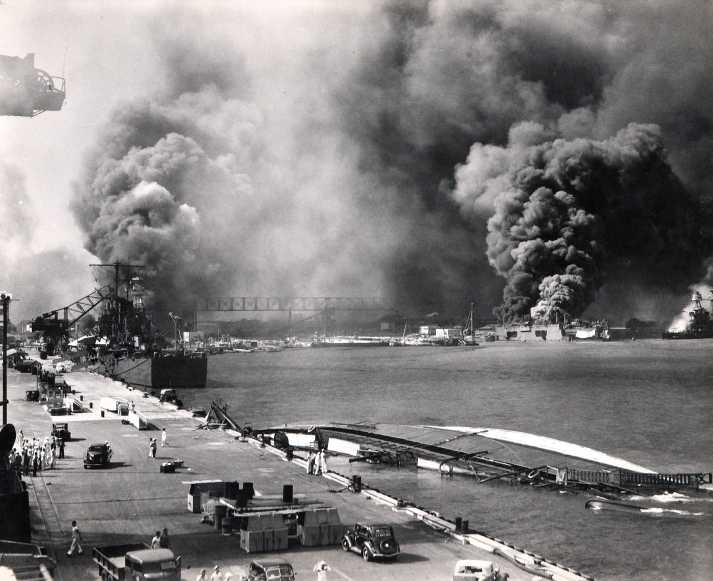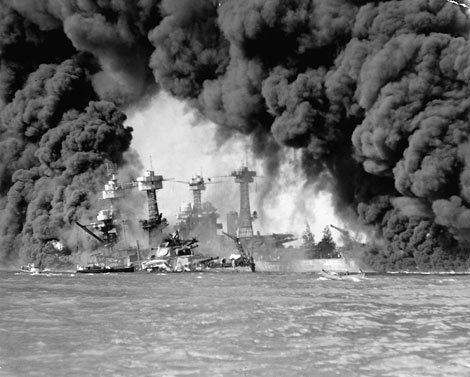
Glendora resident Theodore Roosevelt didn't have to be at Pearl Harbor.
When he first enlisted in the Navy at age 17, they assigned him to work intelligence out of a block house in Long Beach.
But he didn't join the Navy to work intelligence; he joined to go to sea. And the young man could see the ships he wanted to serve on from the slots of his secure block house. So he asked for a transfer. Within days he was onboard the USS Utah.

Despite what he saw and lived over the next five years, he never regretted the decision.
"The whole time I always knew that whatever was going to happen to me - whether I was killed or not - I asked for it," said Roosevelt, a third-cousin of the president of the same name.
What happened to him was a tour of duty that saw 14 major battles, including those at Midway, Guadalcanal, and Okinawa.
And it started with Pearl Harbor - the surprise early morning Japanese attack of a Naval base at Pearl Harbor, Hawaii, 69 years ago today.
Roosevelt was three decks down on the USS Utah when the attack began. The first word the crew got of anything out of the ordinary was a call to man their battle stations. Roosevelt headed down to his position on the fourth deck. Just as he got there, the ship was hit, "blowing a hole the size of this room," he said gesturing to the large den he built on the back of his Glendora home where he lives with his wife of 65 years.
Water started flooding into the ship and Roosevelt scurried back up to the third deck. He looked back at the men below.

"I knew they were drowning. I could read their eyes saying, I wish I was there with you," he said. "I'll never forget that."
Moments later, another torpedo tore through the ship and water again flooded in. This time, Roosevelt was inundated with water. He swam to an open hatch and again escaped to the deck above. There he and another seaman dodged the Japanese air attack by hiding under the ship's turrets, whose guns had been removed years before.
"I didn't know what was going on," Roosevelt recalled.
Eventually Roosevelt slid down off the rolled USS Utah and swam to Fort Island. On shore, he ducked into a construction trench, where he waited out the attack.
"When it was over I got up and saw there was fire everywhere. There were bodies everywhere," he said.
He ran to one of the still-standing buildings, where the injured were brought. There, a few medics attempted to treat the injured. Since Roosevelt was uninjured, but had no medical experience, they assigned him the task of lighting cigarettes and handing them to severely injured men.
He thought he was giving them a little nicotine relief.
"Later I learned that they had what are called gut shots - they were hurt so bad the cigarette drag killed them. I remember, they would take one puff, and go ahhh," Roosevelt said, rolling his head back and closing his eyes.
The medics had assigned the then 17-year-old Roosevelt to put the men - some with huge wounds in their chest or missing their legs - out of their misery.
The next two days, Roosevelt collected bodies from the harbor's waters and buried them in a mass grave at Red Hill Cemetery.
Roosevelt, now 87, recalls the days vividly and tells the story matter of factly, repeating over and over again that he was not a hero.
By Dec. 10, Roosevelt was assigned to serve on the USS Ralph Talbot, a destroyer that would see battle across the Pacific Theater.
"Through it all, I never got a scratch. I have seen so many people killed and hurt all around me. I never not a scratch," he said.
When Roosevelt was 14, the patriarch of his Mormon church gave him a blessing with a foretelling message.
"He said `In your life, you are gonna go through great strife. Men all around you are going to die. But you will come out unscratched,"' Roosevelt said. "I read those words before every battle. But that doesn't mean I wasn't scared."
Read More
http://www.sgvtribune.com/news/ci_16794250
When he first enlisted in the Navy at age 17, they assigned him to work intelligence out of a block house in Long Beach.
But he didn't join the Navy to work intelligence; he joined to go to sea. And the young man could see the ships he wanted to serve on from the slots of his secure block house. So he asked for a transfer. Within days he was onboard the USS Utah.

Despite what he saw and lived over the next five years, he never regretted the decision.
"The whole time I always knew that whatever was going to happen to me - whether I was killed or not - I asked for it," said Roosevelt, a third-cousin of the president of the same name.
What happened to him was a tour of duty that saw 14 major battles, including those at Midway, Guadalcanal, and Okinawa.
And it started with Pearl Harbor - the surprise early morning Japanese attack of a Naval base at Pearl Harbor, Hawaii, 69 years ago today.
Roosevelt was three decks down on the USS Utah when the attack began. The first word the crew got of anything out of the ordinary was a call to man their battle stations. Roosevelt headed down to his position on the fourth deck. Just as he got there, the ship was hit, "blowing a hole the size of this room," he said gesturing to the large den he built on the back of his Glendora home where he lives with his wife of 65 years.
Water started flooding into the ship and Roosevelt scurried back up to the third deck. He looked back at the men below.

"I knew they were drowning. I could read their eyes saying, I wish I was there with you," he said. "I'll never forget that."
Moments later, another torpedo tore through the ship and water again flooded in. This time, Roosevelt was inundated with water. He swam to an open hatch and again escaped to the deck above. There he and another seaman dodged the Japanese air attack by hiding under the ship's turrets, whose guns had been removed years before.
"I didn't know what was going on," Roosevelt recalled.
Eventually Roosevelt slid down off the rolled USS Utah and swam to Fort Island. On shore, he ducked into a construction trench, where he waited out the attack.
"When it was over I got up and saw there was fire everywhere. There were bodies everywhere," he said.
He ran to one of the still-standing buildings, where the injured were brought. There, a few medics attempted to treat the injured. Since Roosevelt was uninjured, but had no medical experience, they assigned him the task of lighting cigarettes and handing them to severely injured men.
He thought he was giving them a little nicotine relief.
"Later I learned that they had what are called gut shots - they were hurt so bad the cigarette drag killed them. I remember, they would take one puff, and go ahhh," Roosevelt said, rolling his head back and closing his eyes.
The medics had assigned the then 17-year-old Roosevelt to put the men - some with huge wounds in their chest or missing their legs - out of their misery.
The next two days, Roosevelt collected bodies from the harbor's waters and buried them in a mass grave at Red Hill Cemetery.
Roosevelt, now 87, recalls the days vividly and tells the story matter of factly, repeating over and over again that he was not a hero.
By Dec. 10, Roosevelt was assigned to serve on the USS Ralph Talbot, a destroyer that would see battle across the Pacific Theater.
"Through it all, I never got a scratch. I have seen so many people killed and hurt all around me. I never not a scratch," he said.
When Roosevelt was 14, the patriarch of his Mormon church gave him a blessing with a foretelling message.
"He said `In your life, you are gonna go through great strife. Men all around you are going to die. But you will come out unscratched,"' Roosevelt said. "I read those words before every battle. But that doesn't mean I wasn't scared."
Read More
http://www.sgvtribune.com/news/ci_16794250
No comments:
Post a Comment